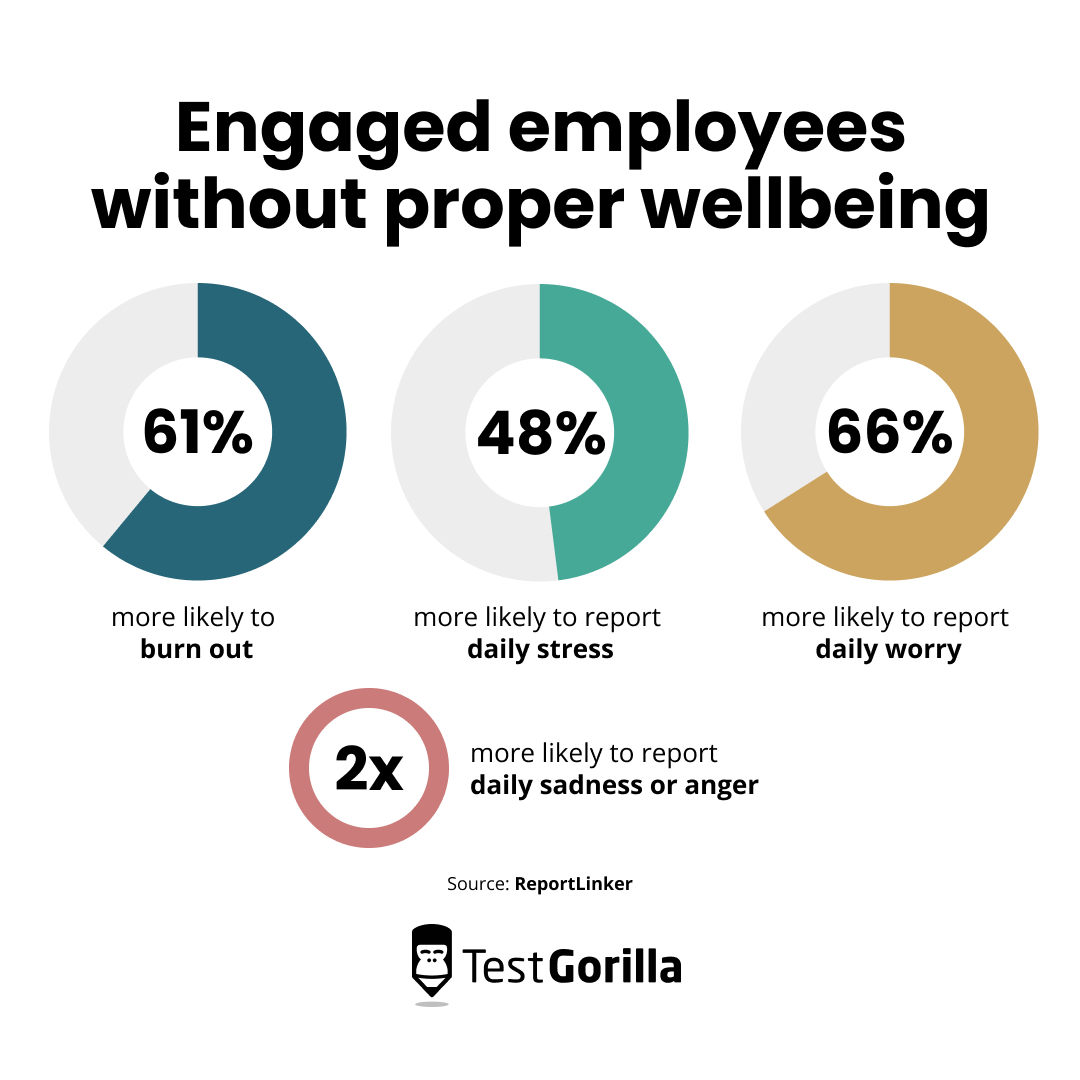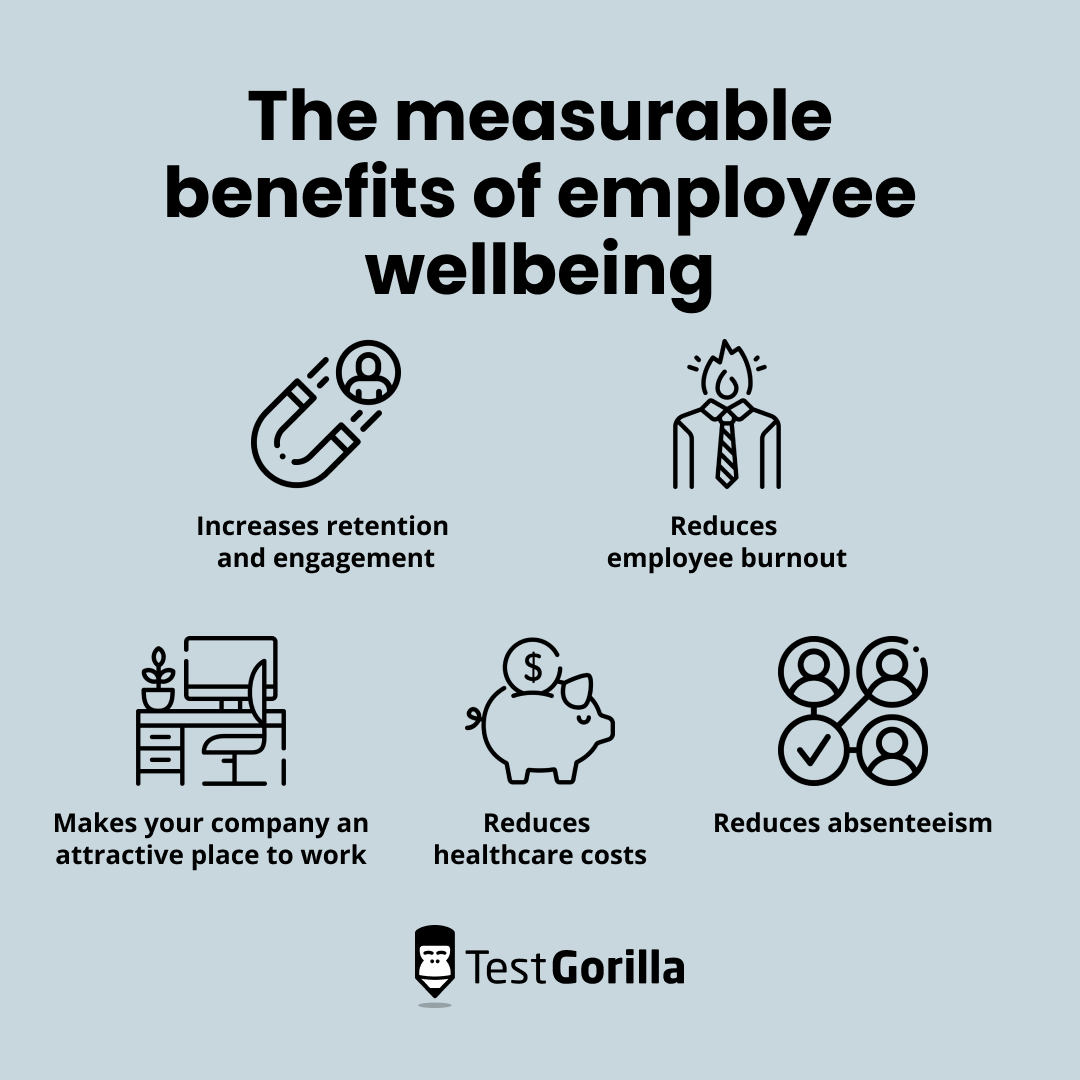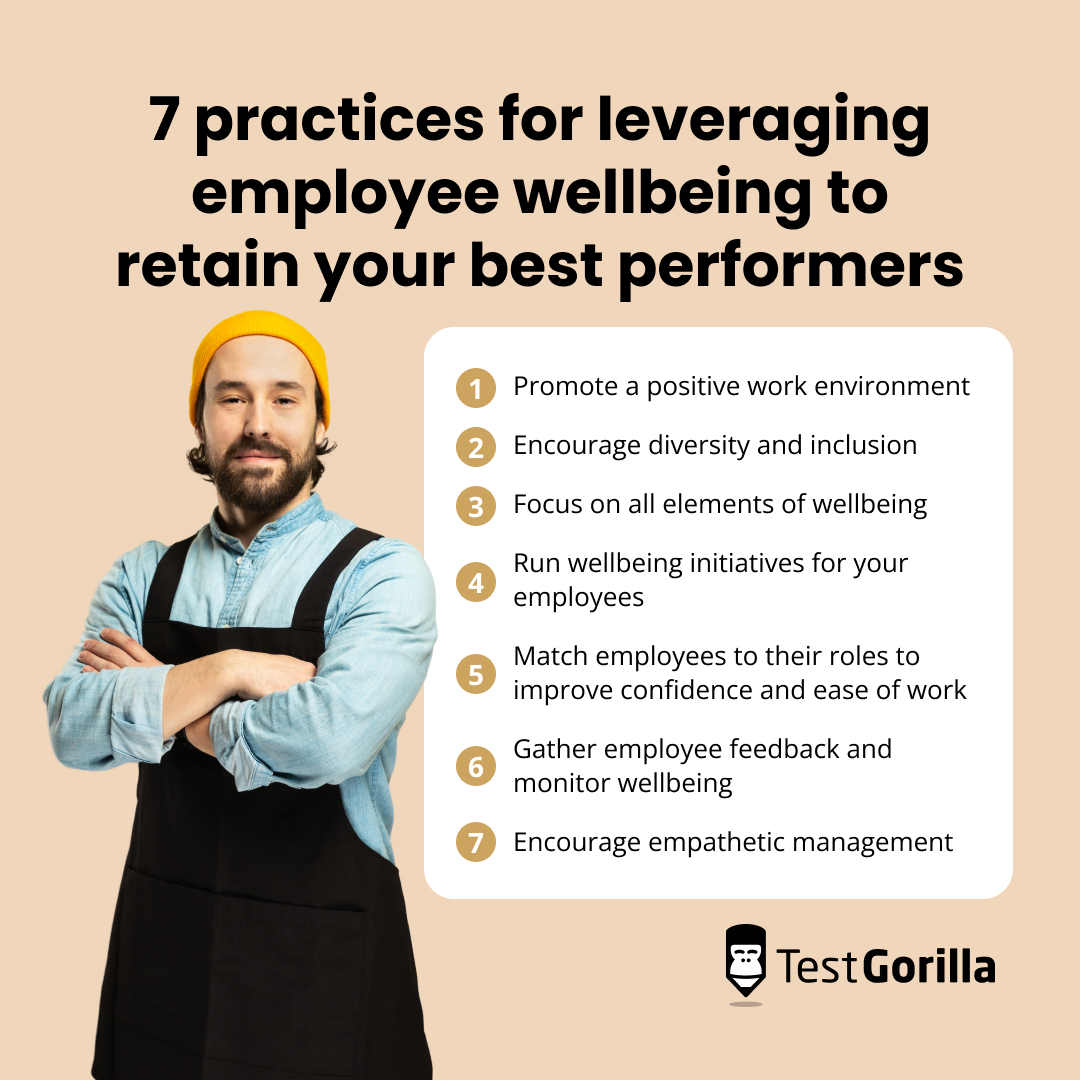Employee wellbeing isn’t “nice to have” – it’s a deciding factor between loyal employees and mass turnover.
Companies that neglect this crucial element of employee health can experience increased anxiety and burnout, two of employee retention’s worst enemies.
One study found burnout makes workers nearly 3.4 times more likely to start looking for a new job. The same report found that 42% of employees were experiencing burnout at the end of 2022.[1]
Further, anxiety and burnout contribute to a toxic company culture, which is the greatest driver of attrition.[2]
This makes employee wellbeing a talent retention trend you need to take seriously.
Taking an active approach to employee wellbeing not only helps secure talent for years to come but also helps improve performance and productivity in the short term.
This article talks in depth about employee wellbeing and its important role in talent retention. We also discuss the top benefits of prioritizing wellbeing and best practices to promote it in your company.
Table of contents
- What is employee wellbeing?
- Why is employee wellbeing in the workplace important?
- The benefits of employee wellbeing
- 7 best practices for leveraging employee wellbeing to retain your best performers
- Employee wellbeing: 3 examples of companies succeeding with this talent retention trend
- Boost employee wellbeing by focusing on skills
What is employee wellbeing?
Employee wellbeing refers to the health and comfort of a worker throughout all aspects of their job, such as physical and mental health, job satisfaction, and work-life balance.
Employee wellbeing has two main components:
How your company impacts staff in and out of work. For example, an organizational restructuring might cause them stress levels that influence their performance and mental health.
How your company supports their personal lives so they can give their best performance. One example is ensuring they have access to flexible work hours so they can get adequate rest.
Learning how to improve employee wellbeing is crucial to a company’s overall health and success, which makes it an essential part of your overall employee retention strategy.
The main elements of employee wellbeing
Employee wellbeing in the workplace isn’t one-dimensional, and it’s important to consider multiple aspects of it.
Here are the seven most common elements of employee wellbeing:
Health: This refers to access to physical and mental health care, comfortable working conditions, and proper physical safety at work
Good work: This is the quality of an employee’s work, including fair compensation, autonomy, and a balanced workload
Values: Values are an important part of work, including an inclusive company culture, high ethical standards, and reliable leadership
Personal growth: This element is all about supporting employees through career growth and offering development opportunities
Social life: Employees need healthy social wellbeing, including a cohesive workplace culture and opportunities to socialize with colleagues
Financial wellbeing: This refers to helping workers with monetary issues, such as providing financial planning and offering solid employee compensation and benefits
Good lifestyle choices: Employees need to be supported in positive lifestyle choices, such as healthy eating and regular exercise because these choices directly affect their work
All seven of these points are important to a great employee experience.
It’s necessary to consider every element in your employee wellbeing strategy to properly engage and retain your people.
We’ll discuss that in depth next.
Why is employee wellbeing in the workplace important?
Increasingly more leaders are putting a focus on wellbeing.
A 2021 study found that 68% of leaders rated employee mental health and overall wellbeing as a top priority.
In 2022, the global corporate wellbeing market was estimated at $70.1bn. But employee wellbeing trends and popularity continue to spike with time – a report from 2023 found the wellbeing market is now estimated to reach $117.9bn by 2030.
This impressive increase is due to employees simply prioritizing their own wellbeing so highly, especially since the Great Resignation of 2021. This shift made companies react, offering more and better wellbeing initiatives.
Because of this, increasingly more candidates expect stellar employee wellbeing in the workplace, driving demand.
Now let’s dive into the key reasons why wellbeing is an essential consideration for employers:
Increases retention and reduces turnover: Building a solid employee wellbeing strategy improves your employee retention rate. Workers need recognition and support, or they’ll find a new place to work.
Work influences home, and home influences work: Many elements of employee wellbeing aren’t strictly work-related, but they still affect job performance. The better you make your employees’ lives, the better their work will be.
Boosts collaboration, problem-solving, and innovation: Employee wellbeing helps improve psychological safety at work, which increases innovation and teamwork in your workforce.
Creates a positive company culture: Improving employee wellbeing promotes a healthier, safer work environment, which reduces employee burnout and quiet quitting.
Wellbeing and engagement boost each other: You need employee wellbeing to have engagement and vice versa. Even if employees are engaged, they still suffer if they aren’t also thriving, which means having balanced wellbeing.
Just engagement isn’t enough – employees need to be thriving to reach their full potential and experience real satisfaction.
Research shows that employees struggle when they’re engaged but not thriving:
61% of workers are more likely to be burnt out
48% are more likely to report daily stress
66% are more likely to experience daily worry
Workers are two times more likely to report daily sadness or anger
We admit it’s a bit obvious, but it has to be said that employee wellbeing benefits your workforce, too.
We’ll sidestep the obvious and mention the more subtle ways employee wellbeing impacts a worker. For example, a balanced workload and a good company culture make work easier to complete.
Improving employee wellbeing also makes work more positive for employees, increasing their overall experience.
The benefits of employee wellbeing
The advantages of improving employee wellbeing have been proven by many studies, including positively impacting retention and reducing absenteeism.
Let’s take a look at the measurable benefits of employee wellbeing.
Increases retention and engagement
Prioritizing employee wellbeing in the workplace is essential to boost retention and reduce your employee turnover rate.
Your workers need to know they’re valuable. They need to feel recognized as humans and not just job roles, or they’ll start searching for better opportunities.
Employees who believe their companies care about their wellbeing are:
69% less likely to actively search for a new job
71% less likely to report experiencing a lot of burnout
3 times more likely to be engaged at work
5 times more likely to strongly agree they trust the leadership of their organization
5 times more likely to strongly recommend their company as a place to work
This last point means that a great employee wellbeing strategy not only retains current staff but also benefits an employee referral program, attracting new quality candidates.
Reduces employee burnout
Employee wellbeing reduces burnout and helps mitigate the negative factors that cause burnout in the first place.
According to a study on employee wellbeing by McKinsey and Company, an unhealthy work environment caused by high levels of toxic behavior is 7.6 times more likely to cause burnout in employees than an environment that’s low in toxic behavior.
The same study found that these burnt-out employees are 6.3 times more likely to leave their jobs, tying employee wellbeing back to retention yet again.
Makes your company an attractive place to work
Prioritizing employee wellbeing boosts your reputation and employer branding.
Your employer branding is how the public and your employees perceive your value as an employer, so it directly affects how you attract new candidates and encourage employee referrals.
One study found that employees who feel cared for at work are 3.2 times more likely to be happy at work and 3.7 times more likely to recommend working for the organization.[3]
A company that cares about its people is incredibly valuable, and many candidates are on the lookout for one. Being one of them helps you stand out from the crowd.
Reduces healthcare costs
Actively combating burnout, stress, and anxiety – as well as promoting physical activity – makes employees less reliant on healthcare.
This study from the Harvard Business Review found that employees who received one-on-one coaching about health and wellbeing had reduced healthcare costs. Employers saw annual cost savings of $1,113 per participant.[4]
A well-made employee wellbeing strategy focuses on physical and mental health, so it’s logical that it would reduce health issues and, therefore, healthcare costs.
And if your strategy also targets employee emotional wellbeing, you can target all crucial elements of employee health at once. For instance, improving psychological safety and reducing toxic behavior help employees spend less on counseling sessions.
Reduces absenteeism
Improving employee wellbeing reduces absenteeism from two different causes:
Absenteeism from illness
Absenteeism from disengagement
Paying attention to employee health reduces the number of sick days each worker takes. For example, CIPROMS, a medical billing company, introduced an employee wellbeing program and measured its impact on absenteeism.
From 2013 to 2015, the cost of sick days per employee dropped from $507.91 to $443.00.[5]
Further, it helps employees attend work more often because it reduces burnout, quiet quitting, and stress. It also increases happiness levels and engagement, and highly engaged workforces see an 81% difference in absenteeism.[6]
7 best practices for leveraging employee wellbeing to retain your best performers
It’s time to examine seven best practices for building an employee wellbeing strategy that works.
These tactics include encouraging an inclusive atmosphere, ensuring workers have the right skills to perform their jobs, and leveraging a regular employee wellbeing survey.
Let’s dive deeper.
Strategies for using employee wellbeing to boost retention: A summary
Strategies | Description |
1. Promote a positive work environment | Take steps to reduce workplace negativity and encourage employees to ask questions and be themselves |
2. Encourage diversity and inclusion | Make inclusivity a core value in your organization and ensure every employee feels accepted |
3. Focus on all elements of wellbeing | Consider all seven elements of wellbeing when planning your wellbeing strategy |
4. Run wellbeing initiatives for your employees | Assess your company’s needs and implement wellbeing initiatives early in your plans |
5. Match employees to their roles to improve confidence and ease of work | Use objective methods like talent assessments to align employees to job roles that suit them |
6. Gather employee feedback and monitor wellbeing | Send out employee wellbeing surveys regularly to gauge the effectiveness of your strategies |
7. Encourage empathetic management | Convey to leaders the impact they have on wellbeing and hire compassionate managers |
1. Promote a positive work environment
A crucial element of employee wellbeing is encouraging a positive work environment.
Workplace negativity impacts employees more than you’d think. Yelling and harassment affect mental and emotional health, and competitive, overstuffed workloads affect physical health.
Here are a few tips for promoting a positive workplace:
Hire people who are compassionate and empathetic
Take steps to foster a cohesive company culture, especially for a remote workforce where culture can struggle
Nurture an environment of psychological safety by letting employees ask questions and make mistakes
Reduce competitiveness and discourage pitting employees against each other
Encourage employee recognition and gratitude
Acknowledge people for their contributions and skills rather than their tenure and connections
This last point is much easier when you adopt skills-based practices.
In skills-based organizations, companies are much more likely to recognize their employees for their skills rather than their years of experience or education.
2. Encourage diversity and inclusion
An inclusive culture helps employees feel seen, heard, and accepted for who they are, increasing their overall satisfaction and wellbeing at work.
Diversity and inclusion are not only essential for employee wellbeing – they also help create the positive work environment we just discussed.
Here are a few ways to encourage diversity in your organization:
Commit to inclusive hiring practices, such as using inclusive language, assessing candidates with talent assessment tests, and hiring for culture add
Make inclusiveness a core value in your company
Implement diversity training
Invite open dialogue, discussion, and questions
Lead by example and encourage inclusive management
Promoting diversity in the workplace helps cultivate a sense of belonging in your workforce. This creates a workplace where employees feel appreciated – a place where people want to come to work.
3. Focus on all elements of wellbeing
A great employee wellbeing strategy needs to incorporate all elements of wellbeing. This ensures you’re addressing every important employee issue.
For example, you wouldn’t want to focus on physical wellbeing but then disregard internal mobility and growth.
Here are the seven elements of wellbeing from earlier, with examples of how to incorporate them into your overall strategy:
Health: Provide employees with therapy sessions and counseling, as well as access to medical care
Good work: Offer fair compensation and perks, such as flexible working conditions
Values: Ensure that employees align with and understand your company’s work culture and mission
Personal growth: Offer employee coaching, mentorship, and career growth opportunities
Financial wellbeing: Give financial advice and coaching through dedicated third parties
Social life: Provide opportunities for remote employees to stay connected with their team and help them open up during one-on-one meetings
Good lifestyle choices: Give workers access to nutritional advice and a wellness app
You can find opportunities to address all seven of these elements in your wellbeing initiatives. Speaking of…
4. Run wellbeing initiatives for your employees
Wellbeing initiatives are an important part of your strategy, and it’s best to consider them early on in your considerations.
In fact, to optimize your budget and execution, it’s a good idea to assess which initiatives are best for your organization during the early stages of planning your employee wellbeing strategy.
Deciding initiatives in advance also enables you to weave them into your employee benefits program.
Here are some popular examples of wellbeing initiatives:
Offering professional development plans to encourage learning and growth
Promoting a healthy work-life balance and implementing a remote work policy
Providing remote employees with a work-from-home office budget
Supporting financial planning
For our full list and actionable advice, check out our blog on employee wellbeing initiatives.
5. Match employees to their roles to improve confidence and ease of work
Employees perform their roles more effectively, confidently, and easily when they have the right skills for the role.
People can easily get overwhelmed and stressed when they aren’t prepared for their work. Alternatively, they can get bored when they have no challenges.
It’s difficult to accurately assess if a candidate suits a role well with traditional means, but hiring the right people is simple when you use talent assessment tests.
Skills tests give you objective data on whether or not a candidate suits a role. This hiring method doesn’t rely on unconscious bias, resumes, or years of experience, so it gives you an accurate picture of the candidate’s capabilities.
Here’s how it works:
First, candidates complete an assessment, usually containing three to five tests. After they’re done, you receive the results on your dashboard.
From here, you can evaluate candidates based on their test scores. This gives you exact data on who has the right skills for the job.
Matching a candidate’s skills to their job is an essential part of employee wellbeing. It improves job satisfaction and makes employees feel happier.
For more insights on this topic, read our guide on skills-based hiring and wellbeing.
6. Gather employee feedback and monitor wellbeing
You can properly promote employee wellbeing by asking your staff what they need. What works for one workplace won’t necessarily be successful for other companies.
An effective way to gather this information is by issuing an employee wellbeing survey to your workforce. Ask them what they’d like to see, what’s currently working, and what isn’t.
It’s also a good idea to talk about it in one-on-one meetings. Let them know you care about their wellbeing and ask where the company could be helping.
And don’t do this once or twice. Stay current on employee feedback by sending employee wellbeing surveys regularly, such as quarterly or biannually.
Another way to monitor your wellbeing strategies is by using employee wellbeing platforms. Many of these systems include metrics and analytics to help you measure the impact of your initiatives.
In fact, many of them take direct feedback from employees to build analytics.
7. Encourage empathetic management
Companies thrive when they have leaders who help their teams. This makes compassionate managers crucial to employee wellbeing and retention.
Unfortunately, poor management is a leading cause of turnover.
One survey found that 46% of respondents said they currently have a manager who makes them want to quit their jobs. Further, 81% of respondents in a managerial role said they want to quit due to a bad boss.[7]
This means that even managers are affected poorly by the management above them.
You can help by encouraging leadership communication and letting them know what an impact they have on their direct reports. Try promoting upward feedback: the practice of employees conveying feedback to their leaders.
It’s also a good idea to hire compassionate managers from the start by using talent assessments to gauge agreeableness and conscientiousness.
For more information on this topic, check out our piece on how to be a good manager (and how to hire one).
Employee wellbeing: 3 examples of companies succeeding with this talent retention trend
Wellbeing trends are sweeping the working world, and many companies are taking advantage of them to boost employee morale and performance.
Let’s take a look at three great examples.
Companies succeeding with employee wellbeing for talent retention: A summary
Company | Why it’s successful |
Buffer | Encourages compassionate leaders who open up to their team |
Nike | Supports many elements of employee wellbeing |
Cockroach Labs | Offers both traditional and nontraditional wellbeing perks |
Buffer
Buffer, a social media management company, knows how to improve mental health in the workplace.
It encourages celebrating the good but also acknowledging the difficult, like anxiety, depression, and burnout.
This company also follows a crucial best practice: having empathetic leaders. Joel Gascoigne, the chief executive of Buffer, is open with his people by expressing his mental health struggles.[8]
Buffer also promotes social support and mental health for remote employees by using a Slack channel to share mental health resources and providing access to online therapists.[9]
These are excellent wellbeing strategies when so many people struggle with working from home depression.
Nike
Nike promotes excellent employee wellbeing through channels targeting mental and physical health, financial wellbeing, and flexible work.
Here are a few examples:
Mental health: Offers free therapy sessions and a range of meditation and mindfulness resources
Physical health: Provides free access to Nike Sports Centers, fitness discounts, and preventative healthcare
Financial wellbeing: Gives workers free financial coaching, tuition reimbursement, stock purchase plans, and performance bonuses
Flexible work: Holds “Summer Fridays” (having Fridays off in the summer months) and a dedicated wellbeing week in August[10]
This company also has a commitment to building and maintaining an inclusive, respectful culture.[11]
Cockroach Labs
Cockroach Labs, a commercial distributed SQL database management system, is dedicated to its employees’ wellbeing.
This company provides free counseling and mental health support through its partnerships with Spring Health and Live Health Online. It also promotes flexible work, so employees can organize their schedules to suit their lives and take time off when they need it.
Cockroach Labs offers more traditional health benefits, such as gym discounts and healthcare coverage for employees and dependents, alongside non traditional benefits like gender-affirming care coverage for trans employees and parental leave for working parents.[12]
Boost employee wellbeing by focusing on skills
Tackling employee wellbeing trends keeps your company ahead of the curve and makes it an attractive place to work.
Employees want to work for an organization that cares about their wellbeing, and they want to stay there for years to come.
Adopt a few of these strategies to start improving employee wellbeing at your company, such as fostering a positive environment and aligning employees’ skill sets to their roles with talent assessment tests.
For more information, check out our guide on employee engagement, a factor that directly affects wellbeing.
To start planning an assessment that helps align candidates to your open roles, browse our test library
Sources
1. "Future Forum Pulse". (February 2023). Future Forum. Retrieved October 9, 2023. https://futureforum.com/research/future-forum-pulse-winter-2022-2023-snapshot/
2. Sull, Donald; Sull, Charles; Zweig, Ben. (January 11, 2022). "Toxic Culture Is Driving the Great Resignation". MIT Sloan. Retrieved October 9, 2023. https://sloanreview.mit.edu/article/toxic-culture-is-driving-the-great-resignation/
3. "The Reinvention of Company Culture". (2022). LinkedIn. Retrieved October 18, 2023. https://business.linkedin.com/content/dam/me/business/en-us/talent-solutions-lodestone/body/pdf/global_talent_trends_2022.pdf
4. Sokol, Michael. (October 3, 2018). “How to Gauge the Effectiveness of Employee Wellness Programs”. Harvard Business Review. Retrieved October 18, 2023. https://hbr.org/2018/10/how-to-gauge-the-effectiveness-of-employe-wellness-programs
5. Rabarison, Kristina M., et al. (August 21, 2017). "A Simple Method to Estimate the Impact of a Workplace Wellness Program on Absenteeism Cost". National Library of Medicine. Retrieved October 18, 2023. https://www.ncbi.nlm.nih.gov/pmc/articles/PMC5724963/
6. Harter, Jim. (April 12, 2017). "Employee Engagement vs. Employee Satisfaction and Organizational Culture". Gallup. Retrieved October 18, 2023. https://www.gallup.com/workplace/236366/right-culture-not-employee-satisfaction.aspx
7. Colvin, Caroline. (January 26, 2022). "Bad managers are pushing out key talent, report says". HR Dive. Retrieved October 18, 2023. https://www.hrdive.com/news/bad-bosses-talent-turnover/617822/
8. “Post”. (March 26, 2019). X. Retrieved October 18, 2023. https://twitter.com/joelgascoigne/status/1110738403853627392
9. Seiter, Courtney. (May 26, 2019). "7 things this tech company does to improve mental health in the workplace". Fast Company. Retrieved October 18, 2023. https://www.fastcompany.com/90355287/7-ways-this-tech-company-does-to-improve-mental-health-in-the-workplace
10. "Working with Well-Being Team at NIKE, Inc". The Muse. Retrieved October 18, 2023. https://www.themuse.com/profiles/nikeinc/team/well-being
11. "FY21 Representation and Pay". (March 9, 2022). Nike. Retrieved October 18, 2023. https://about.nike.com/en/newsroom/resources/fy21-representation-and-pay
12. "Cockroach Labs Employee Benefits". Built In NYC. Retrieved October 18, 2023. https://www.builtinnyc.com/company/cockroach-labs/benefits
Related posts
Hire the best candidates with TestGorilla
Create pre-employment assessments in minutes to screen candidates, save time, and hire the best talent.
Latest posts
The best advice in pre-employment testing, in your inbox.
No spam. Unsubscribe at any time.

Hire the best. No bias. No stress.
Our screening tests identify the best candidates and make your hiring decisions faster, easier, and bias-free.
Free resources
This checklist covers key features you should look for when choosing a skills testing platform
This resource will help you develop an onboarding checklist for new hires.
How to assess your candidates' attention to detail.
Learn how to get human resources certified through HRCI or SHRM.
Learn how you can improve the level of talent at your company.
Learn how CapitalT reduced hiring bias with online skills assessments.
Learn how to make the resume process more efficient and more effective.
Improve your hiring strategy with these 7 critical recruitment metrics.
Learn how Sukhi decreased time spent reviewing resumes by 83%!
Hire more efficiently with these hacks that 99% of recruiters aren't using.
Make a business case for diversity and inclusion initiatives with this data.

























